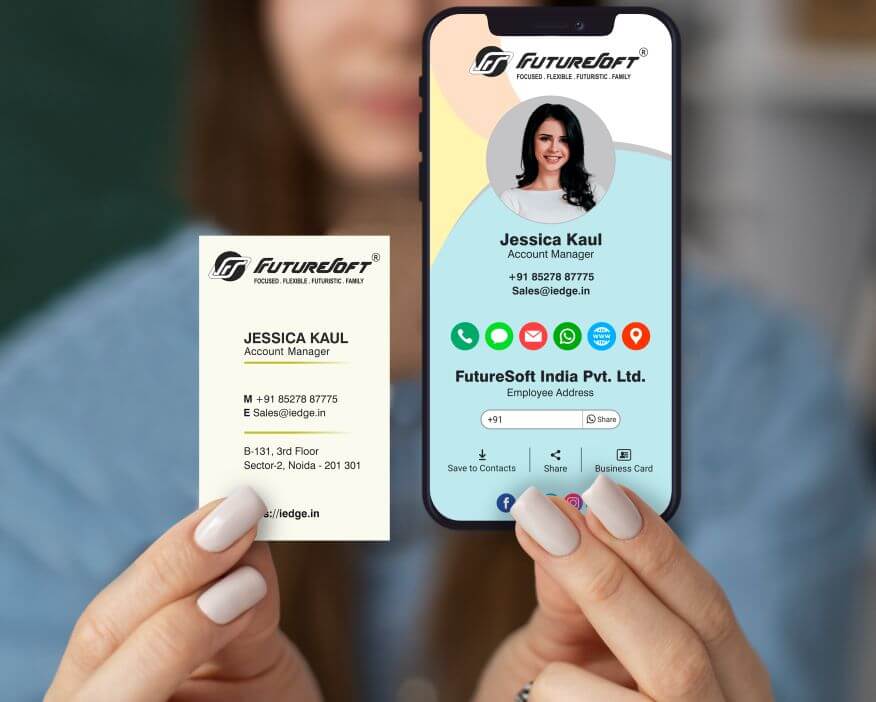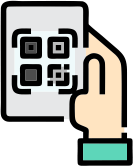Which One is Better: Traditional Vs Digital Business Card
Business cards have long been a staple of professional networking. They have remained a medium of contact sharing whether they are exchanged during a meeting, conference, or chance encounter.
However, with the advancement of technology, digital business cards have emerged as one of the most popular alternatives to business cards. These advanced solutions permit professionals to connect, engage, and follow up with ease through their smartphones or computers.
So, the debate continues: Should you stick with a traditional business card or shift to a digital business card website to create visiting card profiles for your team?
Well, in this blog, we will explore the strengths and weaknesses of both, provide real-world scenarios, and help you decide which option fits your business needs best.
Compare the benefits of traditional and digital business cards to find out which format suits modern networking best in terms of convenience, customization, and lead generation.

Traditional Business Cards
Let’s discuss a real-world scenario. Imagine you are attending a local business expo, walking through booths, exchanging pleasantries, and meeting dozens of professionals. You reach into your jacket pocket, pull out a sleek traditional business card, and hand it over with a smile.
The physical hand-off feels authentic and personal. The recipient places your card in their wallet or business and holder, tangible proof of your interaction.
Pros of Traditional Business Card
1. Tangible and Personal
Nothing beats a face-to-face interaction paired with the exchange of traditional business cards. The physical nature of these cards adds a distinctive touch that strengthens professional rapport.
2. Widespread Acceptance
Despite the rise in digital communication, traditional business cards are accepted universally. Whether you are networking in Tokyo or Toronto, people know exactly how to use them.
3. Branding Potential
The design, paper, quality, texture, and even the scent of a traditional business card can reflect your brand’s identity. And a beautifully crafted card can leave a lasting impression on the card receiver.
4. No Technology Required
Not everyone is tech-savvy. A traditional business card doesn’t require an internet connection or a mobile device. This makes it a practical choice across generations and geographies.
To explore tools that offer these modern features, check out our guide on the Top 5 Virtual Business Card Platforms.
Cons of Traditional Business Cards
1. Limited Information
Due to space constraints, a traditional business card can only include minimal contact details—usually a name, title, phone number, and email address.
2. environmental Impact
Paper production and printing lead to deforestation and pollution. Millions of traditional business cards end up in landfills every year, making them a less sustainable option compared to alternatives to business cards.
3. Easy to Lose
A business card can be misplaced, damaged, or forgotten at the bottom of a bag. Once lost, all your contact information is gone with it.
Digital Business Card
Imagine you are at a virtual conference or a hybrid event. You engage in a quick chat on Zoom, and instead of mailing a traditional business card, you send a link to your digital business card website.
The recipient instantly accesses your profile with a single tap; complete with your photo, clickable contact buttons, and social media links. You can create digital visiting card options that adapt to different audiences, such as potential clients, partners, or vendors.
Pros of Digital Business Card

1. Convenient and Instant
A digital business card can be shared via QR code, link, email, or NFC technology. It eliminates the need for physical exchange, making it incredibly efficient.
2. Eco-Friendly
By using digital business cards, you go paperless, reducing your carbon footprint and supporting sustainability goals. This makes it the greenest among the alternatives to business cards.


3. Interactive and Engaging
Unlike a traditional business card, a digital business card website allows you to include clickable links, videos, portfolio items, calendars, and more, creating a richer user experience.
4. Easy to Update
In case of any major or minor changes, you can update them instantly. Just log in and edit your details on the digital business card and they will be updated in real-time.


5. Trackable
With analytics features, you can track how many times your visiting card digital profile is opened, which links were clicked, and who viewed your contact details.
Cons of Digital Business Cards
1. Tech-Savvy Requirement
Not everyone is comfortable navigating a digital business card website. Some users struggle with the digital interface as it may appear confusing or unfamiliar.
2. Potential for Digital Fatigue
With so many online interactions, some people may feel overwhelmed by another digital interface. A traditional business card can serve as a refreshing break.
3. Device Dependency
Your digital business card requires a working device and an internet connection. In low-connectivity environments, it may not be accessible.
Comparison Chart: Traditional Business Card Vs Digital Business Card
| Features | Traditional Business Card | Digital Business Card |
| Tangibility | Yes | No |
| Easy to Share | Limited | Instant and Global |
| Eco-Friendly | No | Yes |
| Customizable | Limited (Need to reprint) | Highly Customizable |
| Update Capability | No | Yes |
| Trackable Analytics | No | Yes |
| Requires Technology | No | Yes |
Benefits of Traditional Business Card
Despite the rise of alternatives to business cards, the traditional business card still holds its ground in many industries. Here are some of its strongest benefits:
- Personal Connection: Handing out a card strengthens face-to-face engagement.
- Cultural Relevance: In certain countries and sectors, the traditional business card is deeply embedded in business etiquette.
- Simplicity: It doesn’t require apps, software, or devices; just hand it over.
For businesses focused on hyper-local or older demographics, traditional business cards can still be highly effective.
Benefits of Digital Business Card
When it comes to modern networking, a digital business card offers unmatched flexibility and functionality:
- Eco-Conscious: A primary benefit among all is smart alternatives to business cards.
- Dynamic and Editable: Change titles, images, or links in real-time.
- Cost-Effective: No need for reprints or bulk orders.
- Smart Engagement: Integrate with CRMs, calendars, and automation tools.
- Global Reach: Share your visiting card digitally anywhere, anytime.
Whether you are a freelancer, startup founder, or enterprise leader, create digital visiting card profiles to scale your networking.
If you’re focusing on creating a stronger personal identity, check our guide on How to Boost Your Personal Branding with a Personal Business Card.
Which One is Better?
The choice between a traditional business card and a digital business card depends largely on your industry, audience, and workflow.
Choose a traditional business card if:
- You operate in traditional sectors like law or government.
- Your clientele is less tech-savvy.
- You prefer in-person networking events.
Go for a digital business card if:
- You work in tech, real estate, marketing, or remote teams.
- You are looking for sustainable alternatives to business cards.
- Need real-time updates, analytics, and ease of sharing.
- You want to create digital visiting card assets that represent your modern brand.
A hybrid approach also works, carrying a few traditional business cards for in-person events, while keeping a digital business card ready for online interactions or follow-ups.
Conclusion
Besides, the battle between traditional business cards and digital business cards isn’t about which is obsolete; it’s about context. The physical charm of a traditional business card brings personal connection and timelessness.
Meanwhile, the agility of a digital business card delivers speed, engagement, and eco-friendliness. In an increasingly digital world, create digital visiting card profiles to expand your networking game while staying environmentally conscious.
Yet, a powerful first impression, don’t dismiss the effectiveness of a sleek, well-designed traditional business card. Ultimately, the smartest professionals are embracing alternatives to business cards that combine the best of both worlds.
FAQs
Yes, in many cases, a digital business card is much better than a traditional business card due to its convenience, eco-friendliness, and advanced features. With a digital business card website, you can include clickable links, update your details anytime, and track engagement.
These modern features make it one of the top alternatives to business cards. While paper cards still hold value in face-to-face settings, a visiting card digital offers a broader reach, especially for remote networking.
Professionals looking to streamline contact sharing and enhance branding should definitely create digital visiting card profiles alongside traditional ones for maximum impact.
Absolutely. A digital business card is a smart investment for professionals in today’s fast-paced digital world. It’s cost-effective, eco-friendly, and easily customizable. Through a digital business card website, you can instantly share your contact details, portfolio, and social profiles—all from your smartphone.
Unlike a traditional business card, it never runs out or becomes outdated. As more businesses seek paperless solutions, a visiting card digital stands out as one of the best alternatives to business cards.
Whether you're a freelancer or a corporate executive, it's worthwhile to create digital visiting card profiles for seamless, modern networking.
A traditional business card is a printed card you hand out physically, while a digital business card is shared online via QR code, link, or NFC. A paper card is tangible and familiar but limited in content and updates.
In contrast, a digital business card website lets you highlight more information, track views, and make real-time changes. As alternatives to business cards evolve, many professionals now create digital visiting card profiles to engage contacts instantly.
A visiting card digital also supports interactive features like video intros and clickable links, making it more dynamic than its paper counterpart.
Yes, people still use traditional business cards, especially in industries like law, finance, and real estate where face-to-face networking is common. They offer a tactile, individualized touch that digital tools can’t fully replace.
However, many professionals are exploring alternatives to business cards, such as digital business cards. These virtual options provide convenience, instant sharing, and sustainability. Whether at conferences or casual meetings, some blend both formats—handing out a paper card while also sharing a visiting card digital link.
It’s wise to create digital visiting card profiles alongside physical cards to cover both traditional and modern networking needs.
Choosing between paper and digital business cards depends on your needs. A traditional business card excels in face-to-face meetings, offering a personal and tactile experience. But a digital business card website lets you include rich content, update details instantly, and track engagement—making it one of the top alternatives to business cards.
Digital cards are eco-friendly, cost-effective, and ideal for remote networking. Many professionals create digital visiting card profiles to complement or replace paper cards. Overall, a visiting card digital is more versatile, but keeping both options allows you to adapt to any situation or audience.

